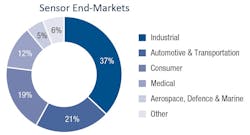The Industrial Internet of Things (IIoT) is nothing without sensors to measure pressures, positions, temperatures and other important production parameters. So it’s understandable that as IIoT and consumer IoT applications grow, the sensor market is taking off as well. And continued innovation in sensor technologies is only helping to fuel the expansion of IoT capabilities that much further.
The $85 billion sensor market has grown at a compound annual growth rate (CAGR) of more than 7.5 percent over the past three years, points out Denver-based investment banking firm Headwaters. That’s expected to grow to more than $115 billion by 2019, with 7.3 percent CAGR.
More sensors are showing up in the automotive industry (with connected and self-driving cars creating a huge demand) and healthcare applications (health monitoring and medical diagnostics being key), but nowhere is demand more significant than in the industrial space, accounting for more than a third of the sensor market.
IIoT is expected to stimulate huge demand for sensors, the Headwaters report says, pointing to industrial data that’s expected to double within the next 10 years. And given the domain expertise of industrial players, IIoT technology should see higher-margin growth opportunities.
As a more mature end market, industrial applications focus more on high-end rather than high-volume production, Headwaters notes, with demand for sensors that can be used in harsh environments with high reliability, precision and miniaturization. And as machine-to-machine (M2M) communications becomes more sophisticated, sensors are helping to enable predictive maintenance, asset monitoring and data analytics for production efficiency gains.
In process automation, systems for process control, process safety, operations management and asset optimization call for the increased use of sensors for measurement and analytical instrumentation, plus control for industrial settings, Headwaters reports. “The recurring theme of integrating multiple sensor technologies with software analytics will enhance the speed and precision of the information flow driving production performance, reliability and safety,” the report says. “The result is an improved cost structure and work environment leading to superior products or processes.”
Mergers and acquisitions
Part of the efforts to better exploit the opportunities in IIoT involve partnering with other tech players and acquiring companies with expertise in real-time data management, asset monitoring capabilities and sensor instrumentation/analytics.
Merger and acquisition (M&A) activity is ramping up in the sensor market, Headwaters executives note, as a way to overcome certain barriers to entry. Traditional sensor companies are snatching up players in new segments, while other technology manufacturers also look to get into the sensor game.
Headwaters analyzed about 100 M&A deals in the sensor sector since January 2013. More than two-thirds had transaction values of less than $200 million, showing the importance of the middle market to sensors. “Typical targets included specialized subsidiaries of large industrial companies and small private players,” the report says.
Sensor companies in the U.S., UK and Europe, at the forefront of innovation, remain good acquisition targets. More than 85 percent of all the M&A deals that Headwaters analyzed were in these geographical areas.
About a fifth of the sensor M&A deals since January 2013 have come from private equity (PE) firms, Headwaters says. “Underlying market characteristics (such as fragmentation and high barriers to entry), along with the considerable growth potential, are likely to see PE buyers continue to invest in sensor businesses, particularly those that offer valuable intellectual property, unique technical capabilities and strong customer bases,” the report explains.
Acquiring companies are also willing to pay more, Headwaters says. They’re paying often well in excess of 12 times the earnings before interest, tax, depreciation and amortization (EBITDA).
Headwaters analysts expect continued M&A strength in the sensor market, which will be key to an increasingly connected and automated world. “As the level of automation becomes more entrenched across key industries, increased sensor utilization will follow,” the report says. “This uptick in demand, along with significant solution-selling opportunities, is likely to continue to attract a number of new entrants into the market.”
Leaders relevant to this article:

